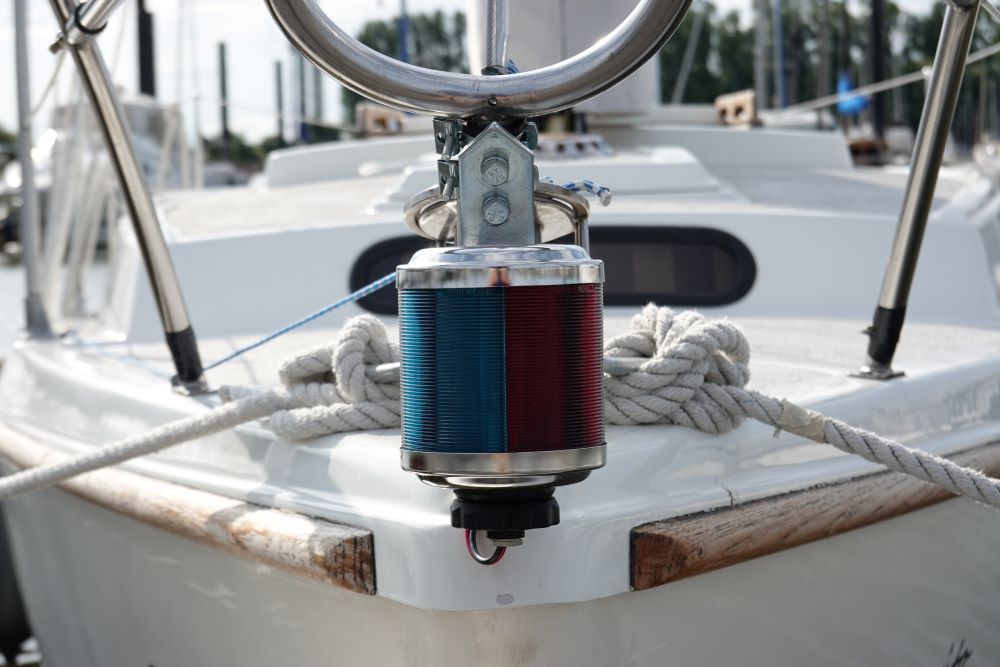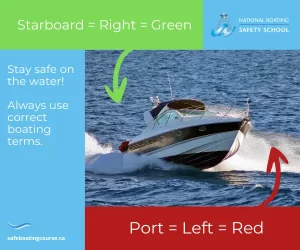
Port and Starboard: What They Mean and How to Remember
If you’re interested in boating, you’ve probably heard the terms port and starboard before. But you might not be sure what they mean.
In this article, the boating safety experts at the National Boating Safety School break down the meaning and origins of the terms, explain why they are so important, and provide a few tricks to help you remember which is which!
Port and starboard: terms meant to eliminate confusion
Left and right should never be used to indicate direction when boating. Port and starboard are used instead.
This may seem confusing at first, but it actually makes sense. Why? Depending whether you are facing forward while steering your boat, or facing a boat coming toward you head-on, the left and right sides of your boat could refer to different things. The terms port and starboard, however, always refer to the same sides of the vessel.
Look at the image below. You are facing the boat in the picture, yet what you would call the ‘left’ while facing the boat, is the starboard. What you would call the ‘left’ while driving the boat is the port. Unlike the terms left and right, which can refer to different things depending on a person’s position, the terms port and starboard always refer to the same parts of the boat, no matter where you are in relation to the vessel.
Definition of port
When looking towards the bow (front) of your boat, the port side is to your left.. Port is usually associated with the colour red, because port side lights are red. Port and starboard navigation lights must always be used in the dark and in conditions involving reduced visibility.
Definition of starboard
When looking towards the bow (front) of your boat, the starboard side is to your right. Starboard is usually associated with the colour green, the colour of starboard side lights.
The origins of port and starboard
The word starboard originated in the early days of boating. Before the invention of rudders on the centreline, boats were maneuvered using a steering oar. Since most sailors were right-handed, the steering oar would usually be located on the right side of the stern. This led to the right side being called the steering side. Two Old English words were combined to form the term starboard: stéor, meaning “steer”, and bord, meaning “side of the boat”.
Since the steering oar was usually on the right, it was much easier to dock boats on the left. That meant that the left side was facing the port, which eventually led to it being called the port side.
The importance of understanding port and starboard
There are many reasons why it’s important to learn to use port and starboard.
First, port and starboard are the official designations for the two sidesof any vessel, as set forth in the International Regulations for Preventing Collisions at Sea. This treaty outlines strict rules that must be followed by all vessels in order to prevent collisions and other incidents on the water.
Second, the terms port and starboard are useful when communicating with other vessels, as they eliminate the risk of confusion and allow boaters to react more quickly and efficiently when passing each other or in the event of an emergency.
Third, f an accident occurs and legal action is taken, any captain or officers who use the terms left and right to refer to a vessel may be held responsible for the damages if the mistake is found to have led to the accident. Always use correct, technical boating language, whether you are referring to navigational concepts like upstream and downstream, or terms describing the parts of a boat like transom or hull. Official terms exist for good reason, and are meant to be used even by beginner boaters.
How to remember the difference between port and starboard
Now that you’re convinced these terms are important, how can you be sure to remember them correctly? Don’t worry, you’re not the first person who has had trouble keeping track of which side is port, and which side is starboard. Here are a couple of tricks that should help:
- The words port and left both have four letters in them. You can use this simple fact to remind yourself that port is on your left when facing the bow. That means starboard must be (and is) on your right.
- Use the sentence: Is there any red port left in the bottle? This trick can help you remember that the left side is the port side, and also that port side lights are red. It can also serve as a reminder that boating under the influence is illegal in Canada and punishable by law.
Learn boating terms with the National Boating Safety School
Knowing the meanings of port and starboard and how to use them is a key element of boating safety.
You also need to have your Pleasure Craft Operator Card (PCOC) with you at all times in order to boat legally on Canadian waters. You can get your card at any time of year by purchasing your boating license online.
Want to find out more about boating safety? The National Boating Safety School is a reliable resource. Our boating safety manual and blog are designed for pleasure boaters who are preparing to take their boating exam online or simply want to refresh their memory before heading out on the water.


